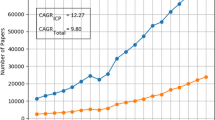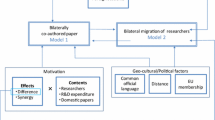Abstract
Most previous studies on research collaboration focus on only one particular indicator or several specific countries. The intention of this work is to examine and compare research collaborations performances in the 41 most productive countries or regions. To this end, we use indicators stemming from authorship datasets from Web of Science an InCites from 1980 to 2019. Five collaboration indicators, with respect to both the size and heterogeneity of research collaboration, were systematically examined. Results showed diversified views of collaboration patterns in different countries or regions by using different collaboration indicators. In the end, we analyzed the correlations between different collaboration indicators and synthesized them by descending dimension method.










Similar content being viewed by others
References
Aboukhalil, R. (2014). The rising trend in authorship. The Winnower, 7, e141832.26907. https://doi.org/10.15200/winn.141832.26907
Adams, J. (2013). The fourth age of research. Nature,497(7451), 557–560.
Adams, J., Pendlebury, D., Potter, R., & Szomszor, M. (2019). Global Research Report: Multi-authorship and research analytics. London UK: Clarivate Analytics.
Aman, V. (2016). How collaboration impacts citation flows within the German science system. Scientometrics,109(3), 2195–2216.
Baba, Y., Shichijo, N., & Sedita, S. R. (2009). How do collaborations with universities affect firms’ innovative performance? The role of “Pasteur scientists” in the advanced materials field. Research Policy,38(5), 756–764.
Bodas Freitas, I. M., Marques, R. A., de Paula, E., & Silva, E. M. (2013). University-industry collaboration and innovation in emergent and mature industries in new industrialized countries. Research Policy,42(2), 443–453.
Bozeman, B., & Corley, E. (2004). Scientists’ collaboration strategies: Implications for scientific and technical human capital. Research Policy,33(4), 599–616.
Chen, Z., & Guan, J. (2010). The impact of small world on innovation: An empirical study of 16 countries. Journal of Informetrics,4(1), 97–106.
Glanzel, W., & Thijs, B. (2004). Does co-authorship inflate the share of self-citations? Scientometrics,61(3), 395–404.
Guan, J., Yan, Y., & Zhang, J. J. (2017). The impact of collaboration and knowledge networks on citations. Journal of Informetrics,11(2), 407–422.
Hsu, J., & Huang, D. (2011). Correlation between impact and collaboration. Scientometrics,86(2), 317–324.
Hu, Z., Chen, C., & Liu, Z. (2014). How are collaboration and productivity correlated at various career stages of scientists? Scientometrics,101(2), 1553–1564.
Hu, Z., Lin, G., Sun, T., & Wang, X. (2018). An EU without the UK: Mapping the UK’s changing roles in the EU scientific research. Scientometrics,115(3), 1185–1198.
Katz, J. S., & Hicks, D. (1997). How much is a collaboration worth? A calibrated bibliometric model. Scientometrics,40(3), 541–554.
Katz, J. S., & Martin, B. R. (1997). What is research collaboration? Research Policy,26(1), 1–18.
Lee, S., & Bozeman, B. (2005). The impact of research collaboration on scientific productivity. Social Studies of Science,35(5), 673–702.
Melin, G. (1996). The networking university—A study of a Swedish university using institutional co-authorships as an indicator. Scientometrics,35(1), 15–31.
Wagner, C. S., Whetsell, T. A., & Leydesdorff, L. (2017). Growth of international collaboration in science: Revisiting six specialties. Scientometrics,110(3), 1633–1652.
Wang, X., Xu, S., Wang, Z., Peng, L., & Wang, C. (2013). International scientific collaboration of China: Collaborating countries, institutions and individuals. Scientometrics,95(3), 885–894.
Yoshikane, F., & Kageura, K. (2004). Comparative analysis of coauthorship networks of different domains: The growth and change of networks. Scientometrics,60(3), 433–444.
Acknowledgements
This work is supported by the National Natural Science Foundation of China (Grant No. 71974030) and the Fundamental Research Funds for the Central Universities of China.
Author information
Authors and Affiliations
Corresponding author
Rights and permissions
About this article
Cite this article
Hu, Z., Tian, W., Guo, J. et al. Mapping research collaborations in different countries and regions: 1980–2019. Scientometrics 124, 729–745 (2020). https://doi.org/10.1007/s11192-020-03484-8
Received:
Published:
Issue Date:
DOI: https://doi.org/10.1007/s11192-020-03484-8




